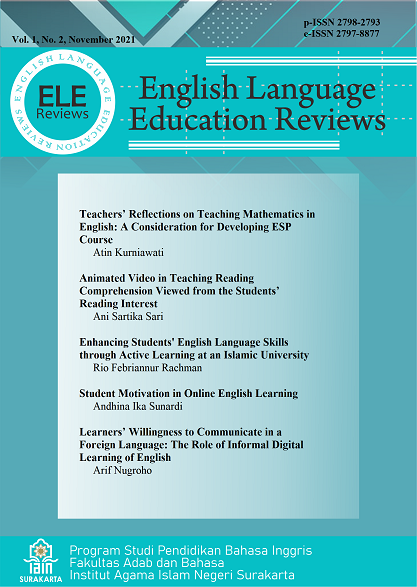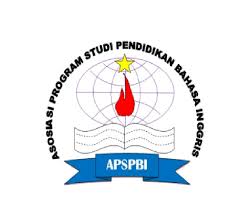Animated Video in Teaching Reading Comprehension Viewed from the Students Reading Interest
DOI:
https://doi.org/10.22515/ele-reviews.v1i2.4062Keywords:
animated video, reading comprehension, reading interestAbstract
The purposes of this study are to find out whether (1) animated video is effective in teaching reading comprehension, (2) students with high reading interest have better reading comprehension achievement than those with low reading interest, and (3) there is an interaction between the teaching media and the students reading interest in teaching reading comprehension. This study is experimental research. The population of this study is the students of MTs Negeri Prambanan. Two classes were taken as the sample, and the sampling technique used was cluster random sampling. This study applied tests and a questionnaire in collecting the data and Kolmogorov-Smirnov formula, One Way ANOVA, and multifactor analysis of variance in analyzing the data. Based on the result of data analysis, the research findings are: (1) animated video is effective in teaching reading comprehension of the students in MTs Negeri Prambanan (Fobtain = 7.60, Sig. Value < 0,05); (2) the students in MTs Negeri Prambanan with high reading interest have better reading comprehension achievement than those with low reading interest (Fobtain = 9.19, Sig. Value < 0,05); (3) there is an interaction between the teaching media and the students reading interest in teaching reading comprehension of the students in MTs Negeri Prambanan (Fobtain = 6.15, Sig. Value < 0,05). Based on these research findings, it can be concluded that animated video is effective in teaching reading comprehension of the students of MTs Negeri Prambanan. It brings improvement to the student's reading comprehension achievement.
Downloads
References
Al-Ghazo, Abeer. (2015). The effect of sq3r and semantic mapping strategies on reading comprehension learning among Jordanian university students. International Journal of English and Education, 4(3), 92-106.
Arsyad, Azhar. (2017). Media pembelajaran. Rajawali Pers.
Harmer, Jeremy. (2015). The practice of English language teaching. London Pearson.
Hidi, Suzanne. (2001). Interest, reading, and learning: theoretical and practical considerations. Educational Psychology Review,13(3), 191-209.
Jolly, Sushma. (2003). Studying the effectiveness of animations and graphics with text on fourth, fifth and sixth graders. Nebraska University.
Khairuddin, Zurina. (2013). A study of students’ reading interests in a second language. International Education Studies, 6(11), 160-170.
Khand, Ziauddin. (2004). Teaching reading skills: problems and suggestions. Journal of Research (Faculty of Languages & Islamic Studies), 5, 43-56.
Mahaputri, Dwi Settya. (2016). The effect of awareness raising technique towards students’ achievement and reading interest. Al-Ta'lim Journal; Padang, 23(3), 232-240.
Mark, Stevens. (2018). Technology enhanced learning for English language learners [Doctoral dissertation, George Mason University]. ProQuest Dissertations Publishing. https://www.proquest.com/docview/2203805608/3D5E647373A34514PQ/1
Poedjiastutie et al. (2018). Task-based language teaching: an alternative approach in teaching reading comprehension in Indonesia. Journal of Asia TEFL; Seoul, 15(3), 856-863.
Renninger, K. A., & Bachrach, J. E. (2015). Studying triggers for interest and engagement using observational methods. Educational Psychologist, 50(1), 1-12.
Rosen, Yigal. (2009). The effects of an animation-based online learning environment on transfer of knowledge and on motivation for science and technology learning. Journal of Educational Computing Research, 40(4), 1-28.
Siregar, Syofian. (2017). Metode penelitian kuantitatif: dilengkapi dengan perbandingan perhitungan manual dan SPSS. Kencana Prenada Media Group.
Smaldino, Sharon, E. (2002). Instructional technology and media for learning. Pearson.
Springer, Sheree E., Harris, Samantha, & Dole, Janice A. (2017). From surviving to thriving: four research-based principles to build students’ reading interest. International Literacy Association, 71(1), 43-50.
Su, Shu-Chin & Eleen, Liang. (2015). Using subtitled animated cartoons and textbook-based CDs to test elementary students’ English listening and reading comprehension in a cram school. International Journal of Applied Linguistics & English Literature; Footscray, 4(1), 106-114.
Sukiman. (2012). Pengembangan media pembelajaran. Pedagogia.
Tarchi, Christian. (2017). Comprehending and recalling from text: the role of motivational and cognitive factors. Issues in Educational Research, 27(3), 600-619.
Downloads
Published
How to Cite
Issue
Section
Citation Check
License
Copyright (c) 2021 Ani Sartika Sari

This work is licensed under a Creative Commons Attribution-NonCommercial 4.0 International License.
Authors retain copyright and grant the journal right of first publication with the work simultaneously licensed under a Creative Commons Attribution License that allows others to share the work with an acknowledgement of the work's authorship and initial publication in this journal.
This ejournal system and its contents are licensed under
a Creative Commons Attribution-NonCommercial 4.0 International License








